If you’ve ever looked at a beautiful garden and thought, “I wish I could do that… but I have no idea where to start,” this guide is for you.
You don’t need years of experience, a huge yard, or fancy equipment to grow flowers. What you do need are the right plants: varieties that are forgiving, fast-growing, and happy to bloom even if you’re still figuring things out.
Below are 7 annual flowers that are truly beginner-friendly, plus simple tips on how to sow, care for, and enjoy them, whether you’re growing in beds, borders, or containers.
All of these are warm-season annuals: they like sun and heat, don’t tolerate frost, and will usually grow from late spring through summer and into fall, then die back when hard frost arrives. You can:
-
start them indoors under grow lights 6–8 weeks before your last frost date,
-
sow them outside after frost has passed, or
-
use methods like winter sowing (mini greenhouses in recycled containers).
Let’s dive in.
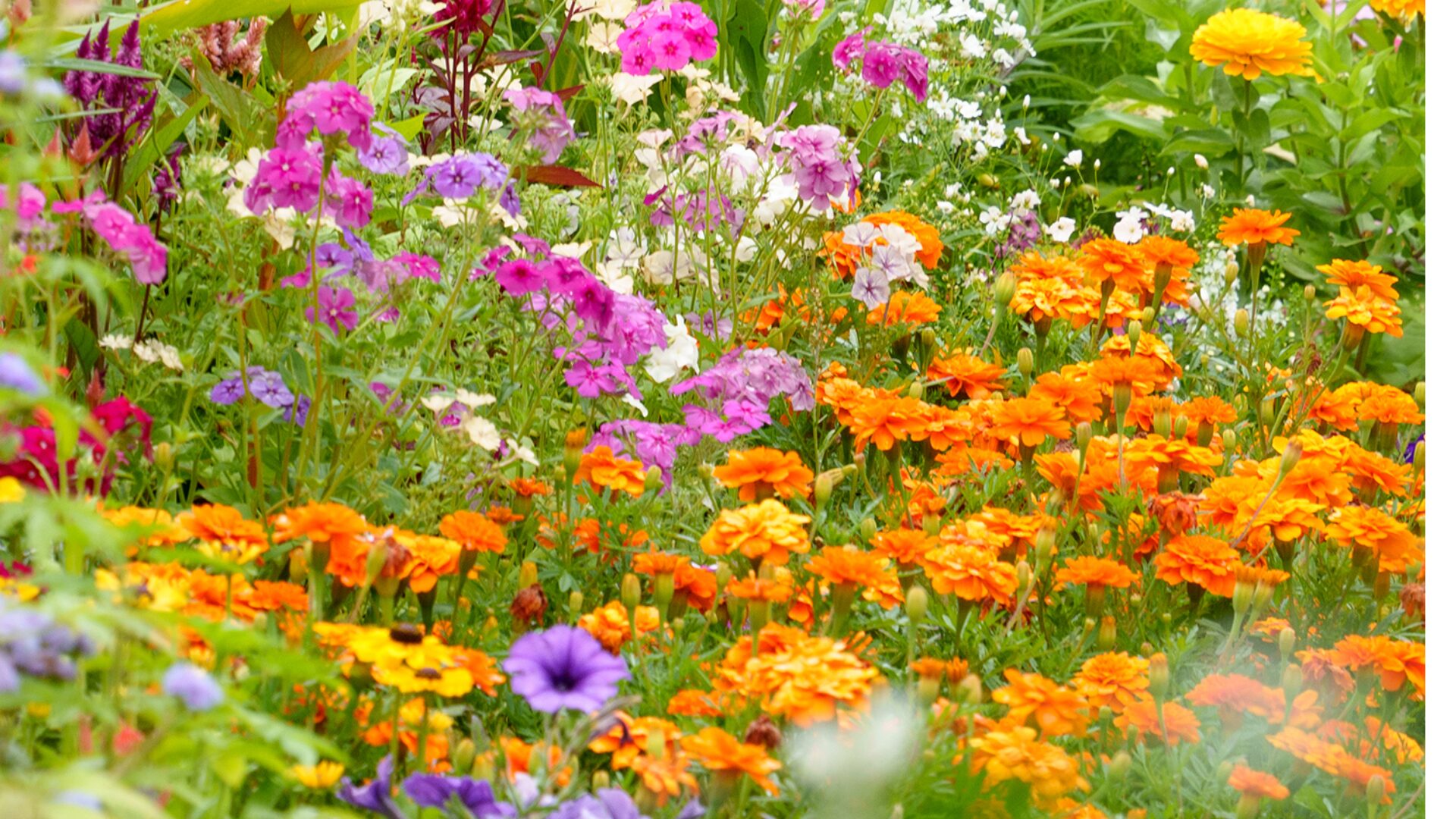
1. Zinnias – The Gateway Flower for New Gardeners
If there’s a “starter flower” that turns people into lifelong gardeners, it’s the zinnia.
Zinnias are:
-
Fast-growing from seed
-
Heat-loving and sun-loving
-
Incredibly colorful, from soft pastels to neon brights
-
Cut-and-come-again – the more you cut, the more they bloom
Why beginners love zinnias
Once your seedlings are established, zinnias are low-maintenance. Give them sun, half-decent soil, and regular watering while young, and they’ll reward you with waves of blooms all season.
They’re also ideal for cut flowers. To know when to cut:
-
Hold the stem halfway up.
-
Gently shake it.
-
If the stem is sturdy and doesn’t flop, it’s ready.
Cut at that stage and the bloom should last 5–7 days in a vase.
Fun varieties to try
-
Queen Lime Series – Elegant ombre tones with layered petals; great for bouquets.
-
Benary’s Giant – Large, dahlia-like blooms in bold colors.
-
Cactus-type zinnias – Spiky, loose petals with a wild, playful look.
If you’re working with pots, window boxes, or front-of-border plantings, look for shorter varieties:
-
Profusion Double White / Double Deep Salmon – Compact (about 12–15″ tall) with 2″ blooms, superb in containers.
-
Zahara Series – About 12–15″ tall, with neat, rounded plants and tons of flowers.
A single seed packet can fill multiple containers or even an entire small bed, making zinnias one of the most cost-effective flowers you can grow.
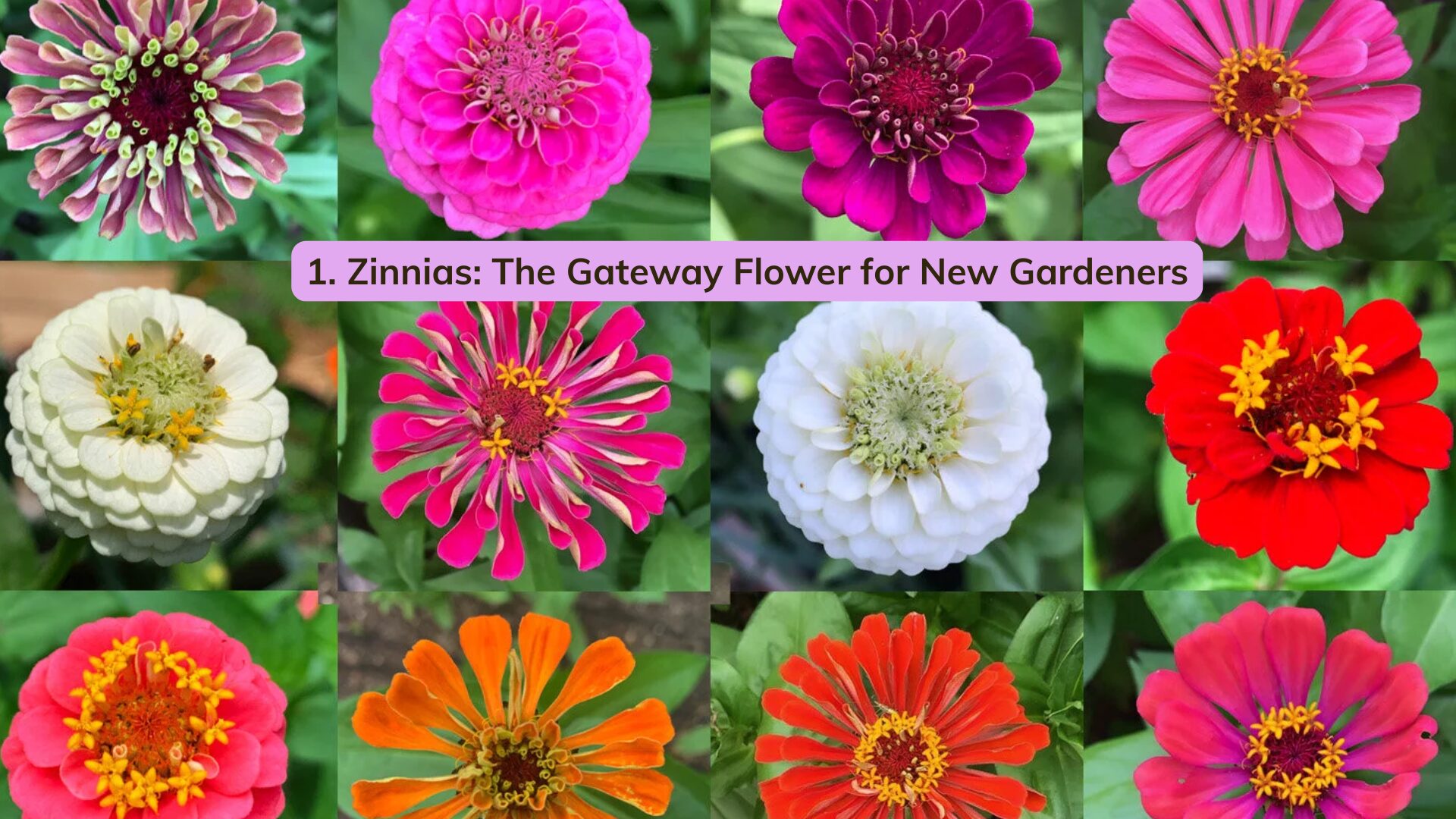
2. Cosmos – Airy, Cottage-Garden Charm
If zinnias are bold and confident, cosmos are their dreamy, cottage-garden cousins.
Cosmos have:
-
Fine, fern-like foliage
-
Daisy-like blooms in whites, pinks, and purples (and more sophisticated tones in newer varieties)
-
A light, romantic presence that softens any garden
How to grow cosmos
Cosmos are very easy from seed:
-
Press the seeds lightly into the soil.
-
Cover with a thin layer of soil.
-
Water gently.
In about 5–7 days, you’ll often see sprouts (even faster in warm conditions).
They love full sun and well-drained soil. Many taller varieties can reach 3–4 feet (or more), so they’re excellent for back borders.
Because taller cosmos can flop in wind or rain, plant them closely together so they support one another and form a dense, upright mass.
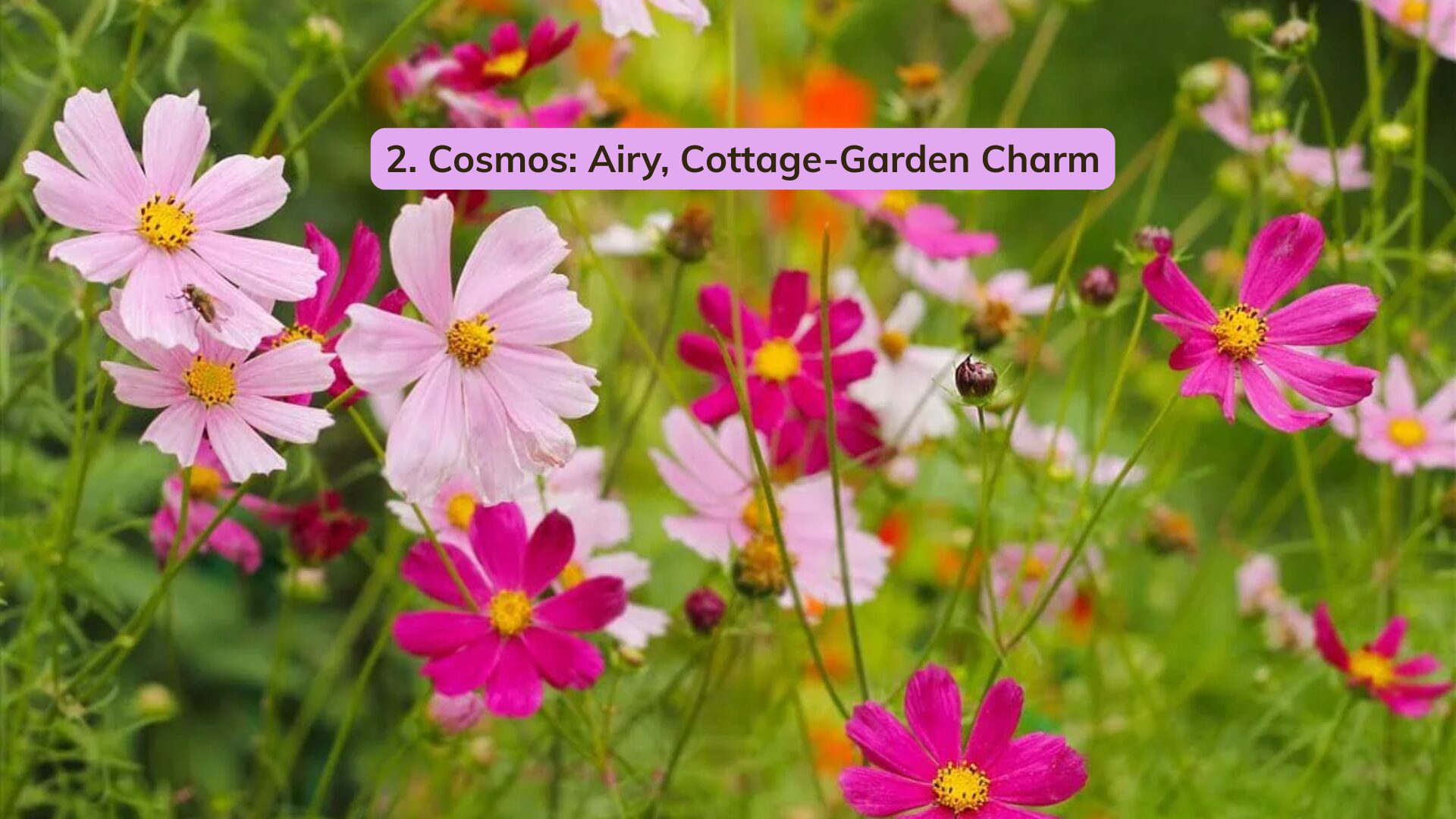
Varieties to explore
-
Double Dutch Rose – Frilly pink blooms with double petals; tall and striking.
-
Daydream – Pink and white petals, delicate and airy.
-
Sonata Series – Shorter (about 1.5–2 feet), better for containers and smaller spaces.
-
Sensation – A classic tall variety with abundant blooms.
Cosmos also make good cut flowers and pair beautifully with zinnias in summer bouquets.
3. Marigolds – Pest Deterrent and Pollinator Magnet
If you already grow vegetables, marigolds are a natural next step. They’re not only cheerful and easy—they’re also useful.
Why marigolds are perfect for beginners
-
They’re beginner-friendly and germinate easily from seed.
-
Deer and rabbits dislike their scent, so marigolds can help protect veggie beds.
-
They bloom in warm weather and keep going into fall.
You can find:
-
Petite, compact varieties great for edges and containers.
-
Taller types better for borders.
-
Colors from classic orange and yellow to new shades like soft creams and multi-tones.
Varieties to try
-
Strawberry Blonde – A newer color range with warm, blended tones.
-
Kilimanjaro White – A creamy ivory marigold with hints of buttery yellow; elegant and a bit taller (often 2–3 feet).
For taller varieties, dense planting can help them stay upright and form a rich display.
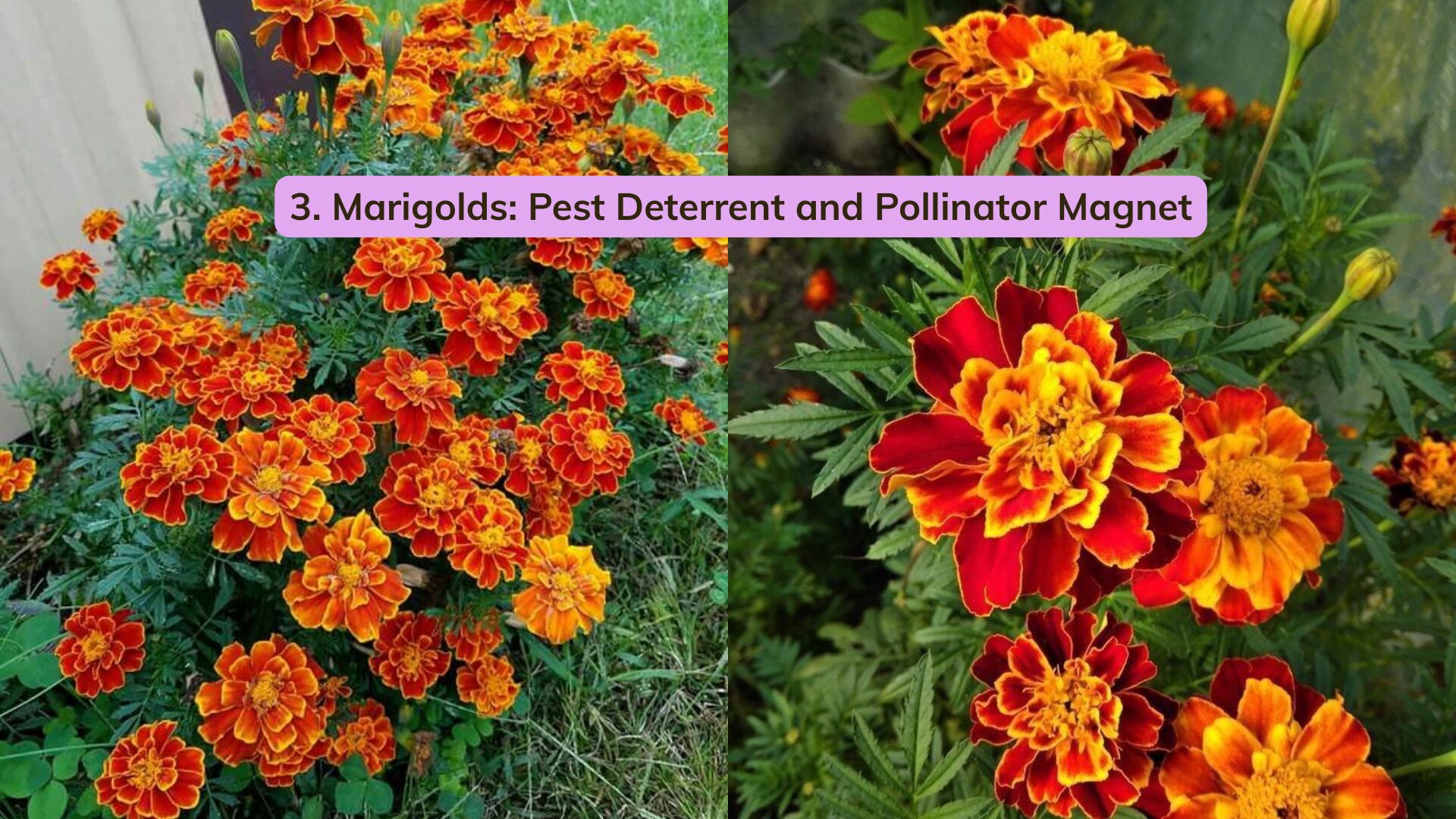
4. Nasturtiums – Edible, Trailing, and Perfect for Containers
Nasturtiums offer triple value: they’re beautiful, edible, and easy.
The flowers and even the leaves have a peppery, tangy flavor, lovely in salads and as garnish. Visually, they make a great alternative to petunias, with a similar trailing habit but a more old-fashioned charm.
Growing nasturtiums
Nasturtiums:
-
Prefer cooler conditions rather than extreme heat.
-
Often slow down or “peter out” in mid-summer heat.
-
Bounce back with fresh blooms as temperatures cool toward fall.
They have a bushy, trailing habit, ideal for:
-
Containers and hanging baskets
-
Edging beds
-
Tumbling over walls or the fronts of planters
A memorable variety to try:
-
Tip Top Alaskan Salmon – Variegated foliage with salmon-orange flowers and a yellow throat. Extremely easy from seed and stunning in mixed plantings.
Sow seeds directly in the garden or in containers after frost, water them in, and they’ll usually germinate without fuss.
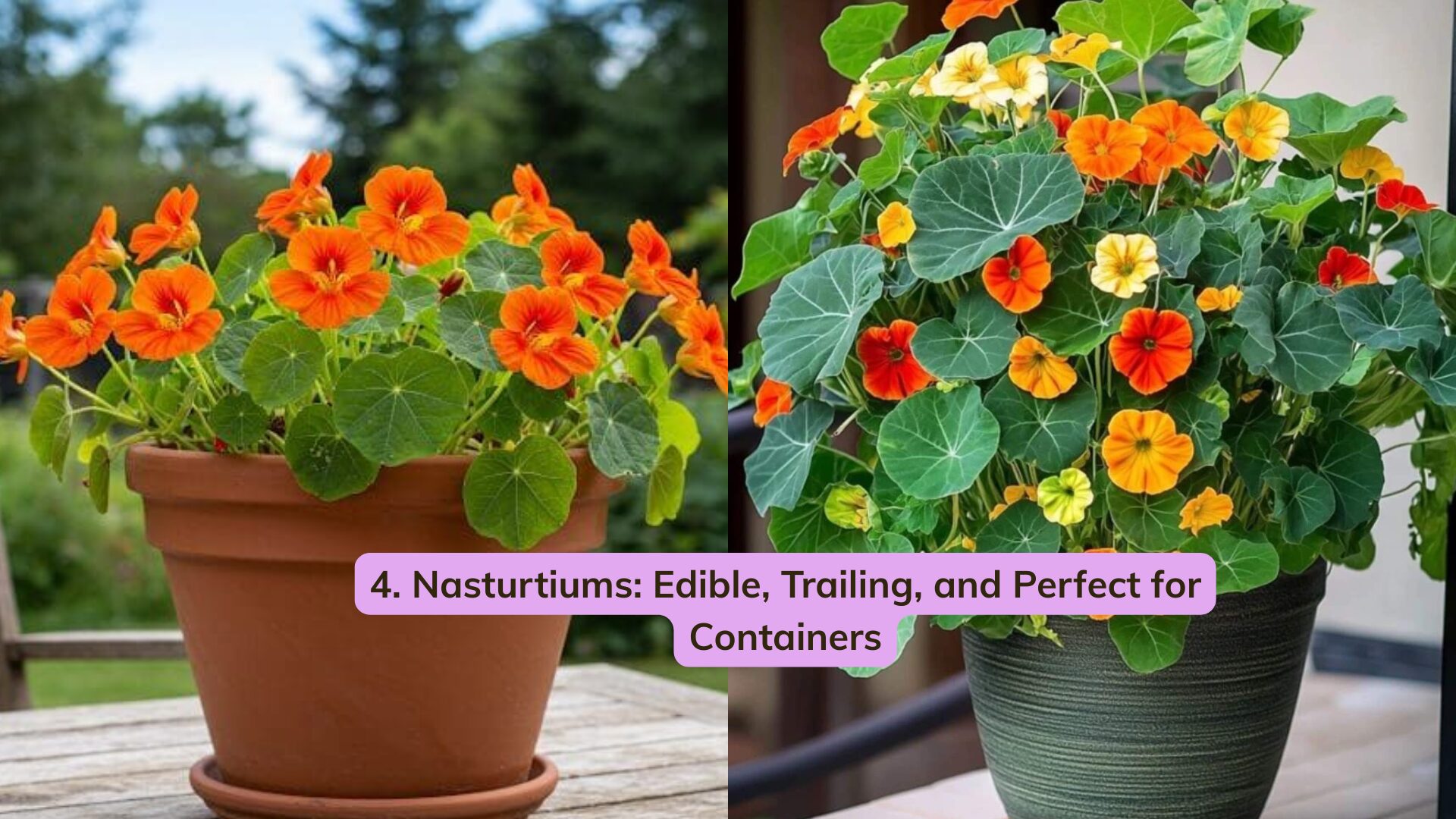
5. Alyssum – Fragrant, Low-Growing, and Incredibly Easy
If you want something that looks like a soft carpet of blooms, choose alyssum.
These plants form low mounds covered in tiny flowers and are perfect as:
-
Fillers in containers
-
Edge plantings along pathways
-
Groundcover-like accents in beds
Why alyssum is a beginner’s best friend
-
Seeds are tiny, but incredibly easy to sow.
-
Simply scatter them on top of the soil, press lightly, and water.
-
They tolerate cooler temperatures better than many other annuals, making them versatile for spring and fall.
You’ll find alyssum in white, purple, and pastel mixes.
Popular options:
-
Carpet of Snow – Classic white, often very affordable and generous in seed quantity.
-
Pastel Carpet Mix – A blend of soft shades (though many seedings may still bloom white).
-
Royal Carpet – A deeper purple option.
They’re ideal as “spillers” in containers, cascading slightly over the edge to soften the look of pots and boxes.
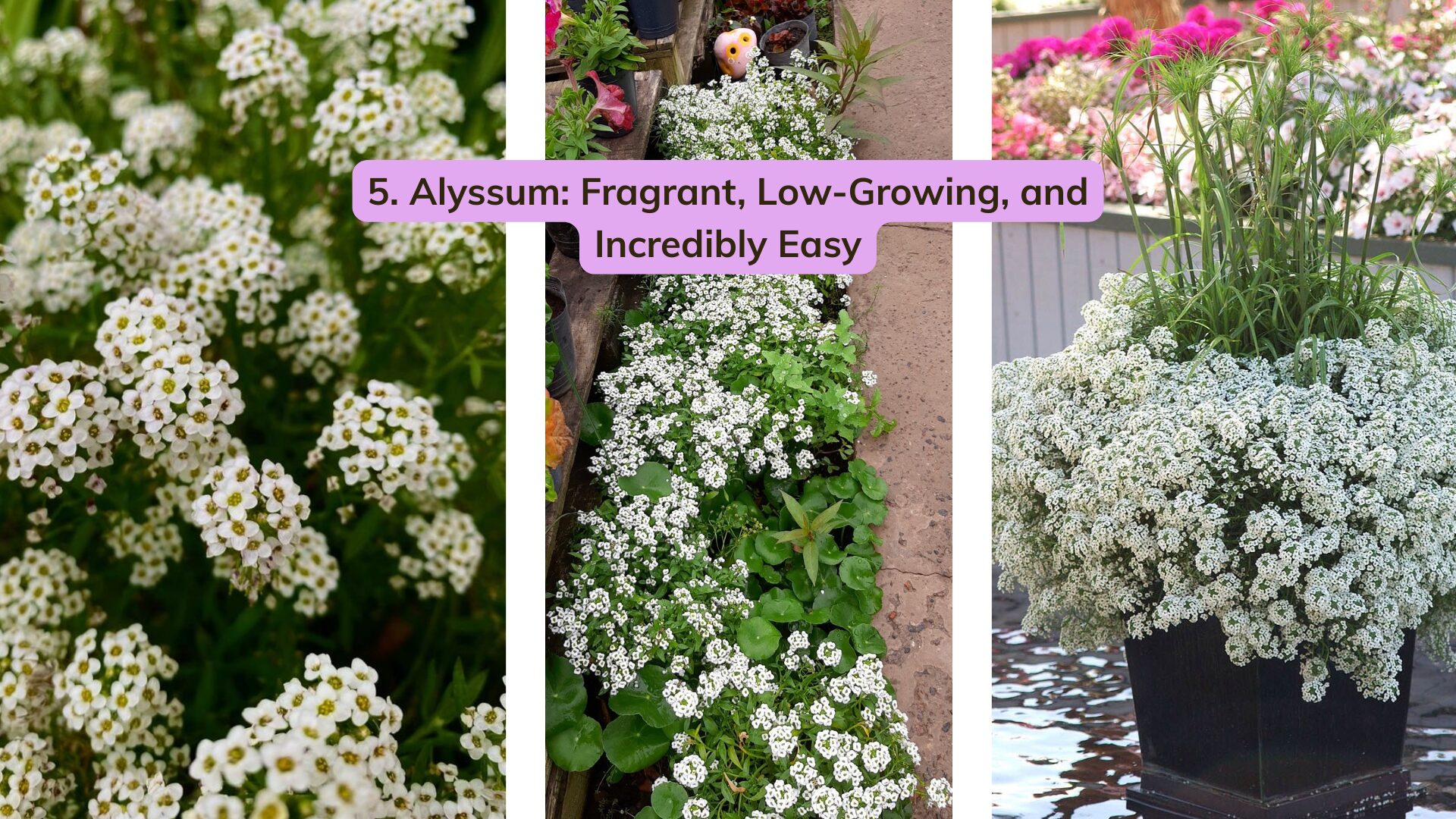
6. Sunflowers – Bold, Joyful, and Surprisingly Forgiving
It’s hard to think of a flower more universally beloved than the sunflower. And despite their dramatic presence, they’re quite simple to grow.
Sunflower basics
Sunflowers:
-
Germinate easily from seed directly sown outdoors.
-
Need full sun and decent soil.
-
Will reach for the light, so plant them where you can see their faces—ideally with the sun behind you.
Some varieties are:
-
Single-stem, producing one large flower per plant (like a bulb).
-
Branching / cut-and-come-again, offering multiple blooms from each plant.
You’ll also find huge mammoth types that can reach 8–12 feet tall and have thick, almost woody stems (sometimes literally requiring a saw to remove at the end of the season). For beginners, mid-sized or dwarf varieties are often easier to manage.
Varieties worth trying
-
Autumn Beauty – Rich tones of yellow, orange, and red for a sunset effect.
-
Strawberry Blonde – Soft pinkish and rose tones, very striking.
-
Incredible – A shorter, branching sunflower (about 20″ high) with 7–9″ blooms, perfect for containers and smaller spaces.
-
Dwarf Teddy Bear – About 3 feet tall with fluffy, fully double flowers that resemble marigolds.
Sunflowers transition beautifully into fall and are perfect in borders, along fences, or as a backdrop for shorter annuals.
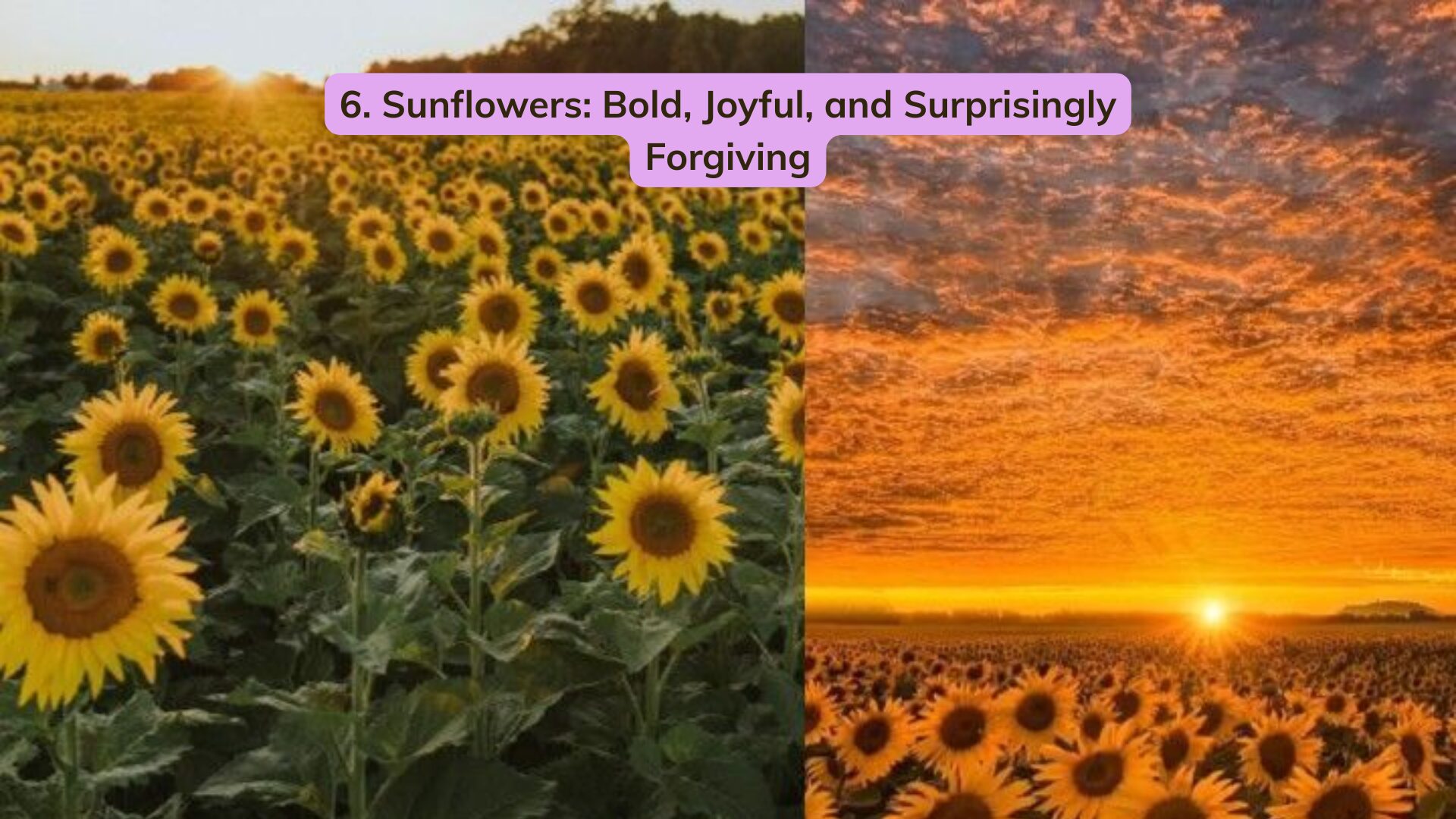
7. Gomphrena – Tough, Long-Lasting Color Buttons
The hidden gem of this list is gomphrena (also called globe amaranth). Many gardeners try it once and become hooked.
Gomphrena offers:
-
Small, globe-shaped flowers that look like bright, papery buttons
-
Remarkable heat and drought tolerance once established
-
A long blooming season from summer into fall
-
Good performance as a cut flower and even for drying
Growing gomphrena
Gomphrena seeds can be soaked for 24 hours before sowing to improve germination. You can:
-
Start them indoors under lights, or
-
Direct sow in warm soil outdoors.
Once they settle in, they’re low-fuss, prolific bloomers. Deer often leave them alone, making them a great choice in areas with browsing wildlife.
Varieties to try:
-
Atomic Purple – Vivid magenta-purple pom-poms that glow in the garden.
-
Snow White – Soft white flowers for a calmer, more classic palette.
Planted along a path or walkway, gomphrena can create a vibrant, colorful border that looks good right up until frost.
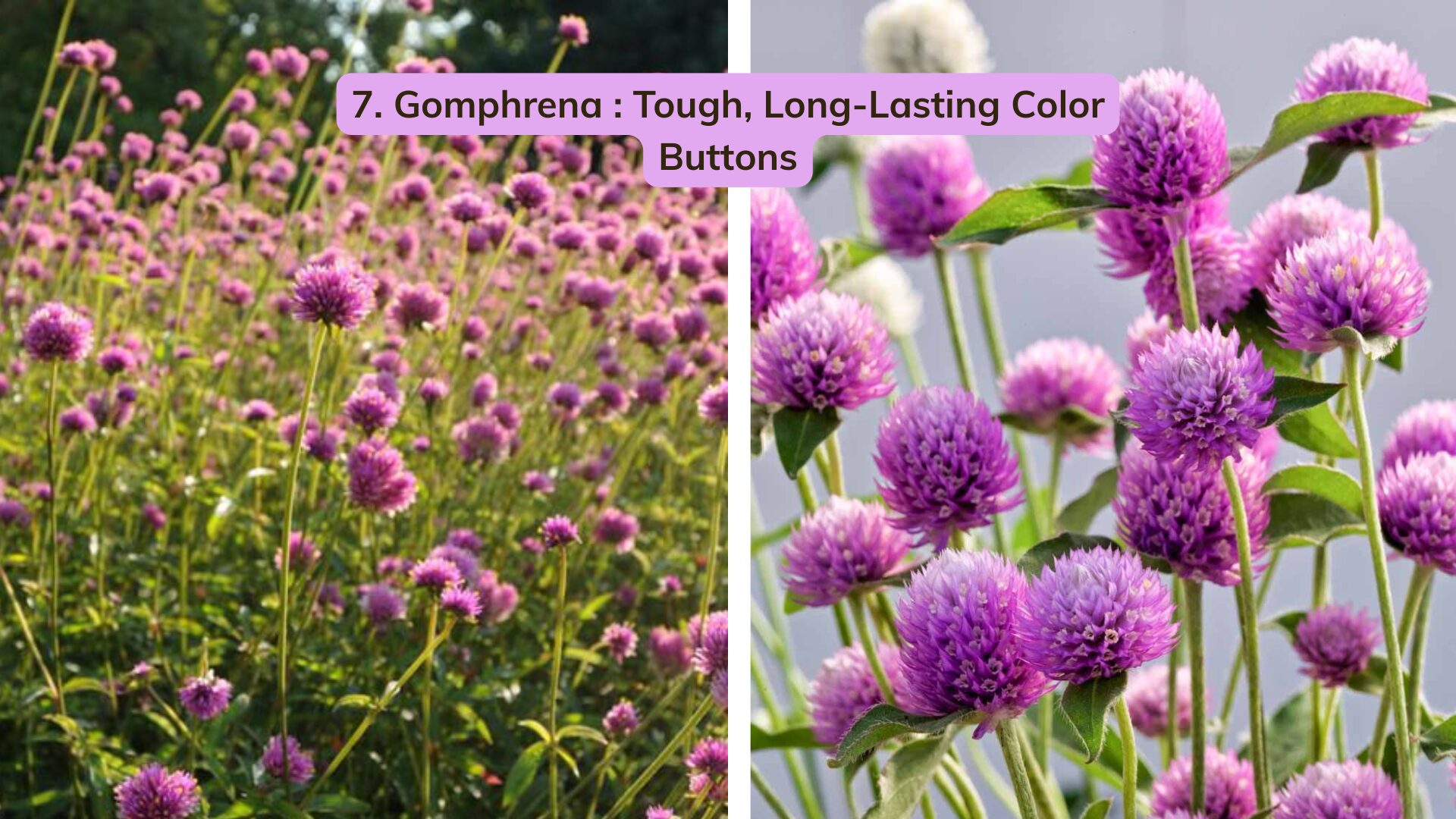
Simple Seed-Starting Tips for Beginners
No beginner’s flower guide is complete without a few practical tips. Whatever you choose to grow from this list, these principles will help you succeed.
1. Plant seeds at the right depth
Seed packets usually tell you how deep to sow. As a rule:
-
Large seeds (like sunflowers or nasturtiums) should be planted deeper—about ¼” to ½”.
-
Tiny seeds (like alyssum) should be scattered on the surface or barely covered.
Some seeds need light to germinate for those, scattering on the surface and gently pressing them in is enough.
2. Water carefully
Seeds and young seedlings need:
-
Consistently moist soil (not bone dry, not soggy) to germinate well.
-
After germination, they still want steady moisture, but overwatering can cause damping off, a fungal issue that makes seedlings collapse.
Water gently and aim for even moisture, not constant saturation.
3. Give them enough light
If you start seeds indoors:
-
A bright south-facing window can work, but seedlings may stretch and become “leggy” if light isn’t strong.
-
Rotate trays or pots daily so all sides get light.
-
For best results, use grow lights placed close above the seedlings.
Alternatively, you can use winter sowing, placing seeds in vented, clear containers outdoors. The natural sunlight and temperatures help create sturdy plants.
4. Pinch for bushier plants
For branching annuals like zinnias and cosmos, you can encourage more side shoots (and more blooms) by pinching:
-
Wait until the plant is about 6–8″ tall with 3–4 sets of true leaves.
-
Pinch or snip off the top growth above a set of leaves.
This encourages the plant to branch out instead of growing as a single, tall stem.
Why These 7 Flowers Are Perfect for Your First Garden
Annual flowers are incredibly useful in a new or evolving garden:
-
They fill empty spaces while shrubs and perennials mature.
-
They offer quick color in the very first year.
-
Many can be grown in containers if you lack garden beds.
-
Growing from seed can save a lot of money compared to buying mature plants.
Whether your goal is:
-
A cut flower patch for fresh bouquets,
-
A cottage-style border full of color and texture,
-
Or simply a few pots of cheerful blooms outside your door,
These seven flowers- zinnias, cosmos, marigolds, nasturtiums, alyssum, sunflowers, and gomphrena give you an easy, reliable starting point.
Start with one or two, gain confidence, and then expand. Gardening, like these flowers, grows season by season. And as you’ll soon discover, planting a seed is more than a gardening act, it’s a quiet promise to yourself that something beautiful is on its way. 🌱🌼


